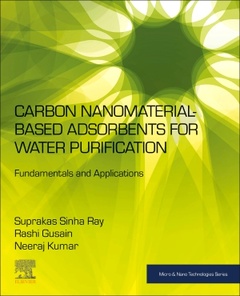Description
Carbon Nanomaterial-Based Adsorbents for Water Purification
Fundamentals and Applications
Micro and Nano Technologies Series
Authors: Ray Suprakas Sinha, Gusain Rashi, Kumar Neeraj
Language: English
Subjects for Carbon Nanomaterial-Based Adsorbents for Water Purification:
Keywords
?Adsorbent dosage; Adsorbents; Adsorption; Adsorption isotherms (such as Henry’s; Adsorption process and the adsorption mechanism; Assay; Biological methods; Biopolymers; Carbon dots; Carbon nano/micromotors; Carbon nanofibers; Carbon nanomaterials; Carbon nanostructures; Carbon nanotubes; Carbon quantum dots; Co-existing ions; Conductive polymers; Contact time; Cytotoxicity; Distillation and evaporation; Dubinin–Radushkevich; Effect; Electrolysis; Environmental; Etc); Flocculation and coagulation; Freundlich; Fullerene; Fullerenes; Functionalization; G-C3N4 and sheets-like nanoporous carbon-based adsorbents; Grafting; Graphene; Graphene nanoplatelets; Graphene oxide; Graphitic carbon nitrides; Heavy metals; Herbicides; Human health; Initial adsorbate concentration; Inorganic salts; Intraparticle diffusion; Ion-exchange; Koble–Carrigan and so on) and kinetic models (First-order; Langmuir; Mechanism; Membrane separation; Nanocomposites; Nanodiamonds; Nanofibers-based adsorbents; Nanomaterials; Nanoporous carbons; Nanotoxicology; Oil spills; Organic dyes; Outlook and future research direction; PH; Personal care and cosmetics; Pesticides; Pharmaceutical ingredients; Photocatalysis and irradiation; Pollutants; Pollution; Polycyclic aromatic hydrocarbons; Pseudo-first-order; Pseudo-second-order; Radioactive substances; Recyclability; Redlich–Peterson; Reduced graphene oxide; Regeneration; Reusability; Second-order; Self-propelled; Sources; Temkin; Temperature; Three-dimensional carbon nanostructures-based adsorbents; Toxicity; Water; Water purification; Water treatment; Zero-dimensional carbon nanomaterials
213.03 €
In Print (Delivery period: 14 days).
Add to cart420 p. · 19x23.3 cm · Paperback
Description
/li>Contents
/li>Readership
/li>Biography
/li>Comment
/li>
The deterioration of water quality and unavailability of drinkable water are pressing challenges worldwide. The removal of toxic organic and inorganic pollutants from water is vital for a clean environment, as a response to water scarcity. Adsorption-based water technologies are among the most widely used because of their high efficiency and low cost, without relying on a complex infrastructure. In recent years, carbon nanomaterials (CNMs), such as graphene and derivatives, carbon nanotubes, carbon nanofibers, nanoporous carbon, fullerenes, graphitic carbon nitride, and nanodiamonds have been extensively exploited as adsorbents due to their extraordinary surface properties, ease of modification, large surface area, controlled structural varieties, high chemical stability, porosity, low density, ease of regeneration, and reusability.
This book provides a thorough overview of the state of the art in carbon nanomaterials as they are used for adsorption applications in water purifications, as well as addressing their toxicological challenges. This volume primarily explores the fundamentals of adsorption, its mechanical aspects, synthesis and properties of CNMs, and adsorption performances of CNMs and their nanocomposites with organic and inorganic materials. Structural engineering and activation processes produce materials with enhanced adsorptive properties and separation efficiencies. Furthermore, the formation of CNMs with 2D and 3D macro-and microstructures and high porosities is a potential approach to improve adsorption performances and extend CNM use at the industrial level. The book also addresses important issues regarding these adsorbents that potentially affect future research and industrial applications of carbon-based nanoadsorbents in water security.
1. Introduction2. Classification of water contaminants3. Water purification using various technologies and their advantages and disadvantages4. Adsorption in context of water purification5. Adsorption equilibrium isotherms, kinetics and thermodynamics6. Effect of reaction parameters on the adsorption7. Carbon nanomaterials: Synthesis, functionalization and properties8. Zero-dimensional carbon nanomaterials-based adsorbents9. One-dimensional carbon nanomaterials-based adsorbents10. Two-dimensional carbon nanomaterials-based adsorbents11. Multifunctional three-dimensional carbon nanomaterials-based adsorbents12. Biopolymer functionalized carbon nanomaterials-based adsorbents13. Conducting polymer functionalized carbon nanomaterials-based adsorbents14. Carbon-based nano/micromotors for adsorption15. Regeneration and recyclability of carbon nanomaterials after adsorption16. Toxicity of carbon nanomaterials17. Outlook and future research, development, and innovation directions
Materials scientists and engineers; aquatic sciences
Rashi Gusain is a Research Fellow at University of Johannesburg and also a visiting researcher at CSIR-Pretoria, South Africa. Her research interests focus on development of inorganic materials for photo-degradation of organic water contaminants and CO2 capture and conversion.
Neeraj Kumar is at Thapar Institute of Engineering & Technology, India
- Presents advances in multifunctional 3D superstructures of carbon nanomaterials and their composites for adsorption applications
- Outlines the fundamentals on synthesis and characterization techniques of carbon-based nanostructures and their composites
- Assesses the major toxicological challenges in using nanostructured materials as adsorbents for water purification




